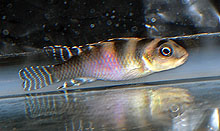Select date in side bar to go to a What's New of previous issues
| What's New
©by Laif DeMason
This winter’s season has begun in earnest with the early arrival of the “polar vortex” sending freezing weather throughout most of the USA by mid-November. Perhaps Mother’s Nature way of warning us of a bad winter to come. Last year was bad enough with some hobbyists telling me they just couldn’t keep their pets warm with their normal heating measures. It is time to review your fish rooms and to be sure your spare power generator and heaters are in place and working when needed. Plan ahead! Here’s “what’s new” on the cichlid scene: |
 The usual collections of Altolamprolous calvus varieties from Zambian locations have dried up over the last several months. This forced exporters to look for similar items elsewhere. From Kekese, Tanzania, the so-called “zebra calvus” (A. compressiceps) was recently collected. |
 Reportedly “re-discovered” by European visitors, Tropheus moorii Tanzanian Murago has been exported lately. Adorned with the characteristic head spots, the original Tropheus Murago from Congo is still a far nicer fish, leaving this new Tanzanian version likely without a long-lasting impact. |
 Collectors in Lake Malawi still harvest Lethrinops species when encountered, seasonally or otherwise. One such fish pictured here is Lethrinops cf. furcifer from Chimate Reef, Tanzania, sporting its usual green hues. |
 One small mbuna from Lake Malawi gaining popularity is Pseudotropheus heteropictus Chizumulu. Males sport a pleasing powder blue coloration when reaching about a 2 inch size. Photo by A. Konings. |
 Imported recently in a small size, Tylochromis intermedius is a slow growing cichlid from Guinea in West Africa. Rarely shipped, this fish has a fair demand from specialty hobbyists. Photo by O. Lucanus. |
 Still available through private breeders, Nanochromis transvestitus is an interesting dwarf cichlid from the Congo. Its name implies that the female pictured here, is the more colorful sex. |